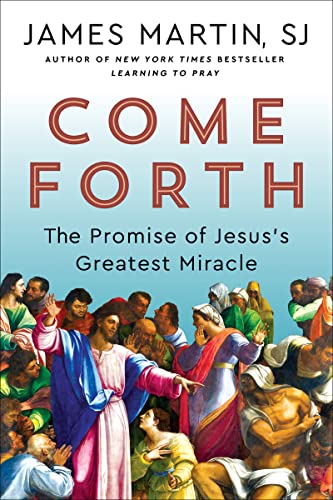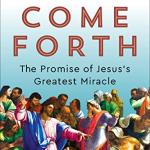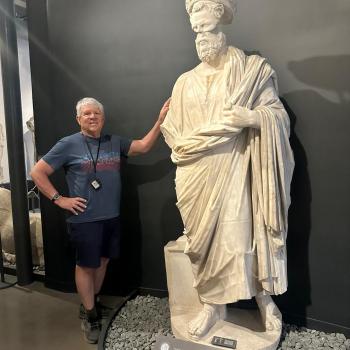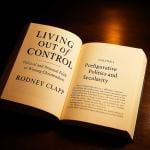James Martin, Come Forth. The Promise of Jesus’ Greatest Miracle, (Harper Collins, 2023), 369pp.
This book is unique in various ways. It is one part historical exegesis, one part theology, one part spiritual formation, one part art history, and one part personal testimony by Father Jim. And as for the exegesis, the whole book is a careful walking through and exposition of exactly one chapter—John 11, the story of Jesus raising Lazarus from the dead. It is written in lay friendly English, and, to mention another miracle—there are no typos in this book. Clearly this author must have a close connection with those angels whose area of expertise is proof-reading. There is classic and contemporary art spread throughout the whole work illustrating the text, and what is most interesting is how Father Jim melds together the interpretations of the artists with the interpretations of the Biblical writers.
Honestly, I’ve seldom read a book where the author is this vulnerable with his audience while at the same time trying to teach them some things and show the relevance of John 11 to his own faith journey as well as that of other Christians. And as for the handling of the scholarly discussion, its carefully done, and with a candor when several possible interpretations have merit. There are no polemics here, no putting the ‘dog’ back into the word ‘dogmatic’, simply refreshingly honest reflection phrase by phrase of this story which is the climax of the so called Book of Signs in the Fourth Gospel. The only miracle after this which could not be topped by anything which comes before it is the miracle of Jesus himself being raised into a resurrection body immune to disease, decay, and death, suffering, sin, and sorrow. The raising of Lazarus foreshadows, but is eclipsed by the raising of Jesus, for Lazarus goes on to die again (see John 21), but not so Jesus.
You will not be surprised to hear that I am thrilled that Father Jim is impressed with, and favors a theory about the Beloved Disciple which I have long advocated, all the way back to my John commentary John’s Wisdom, and more fully argued for in What Have They Done with Jesus, namely the Beloved Disciple is Lazarus, not John son of Zebedee. Indeed, the latter is hardly even mentioned in this Gospel before John 21. John 19-21 tell us that this Gospel is the testimony of an eyewitness, and yet we have none of the special Zebedee stories in this Gospel—the calling from their nets, their presence at the raising of Jairus’ daughter, their presence at the Transfiguration, their request for the box seats in the kingdom, or their presence with Jesus in the garden of Gethsemane. Instead, the ‘Beloved Disciple’ is first mentioned in the phrase in John 11—‘the one whom you love is ill’, and indeed the only disciple spoken of in this way in this whole Gospel is Lazarus. John then, who edited the Beloved Disciple’s witness is like John the elder=John of Patmos. John son of Zebedee, like his brother, and like Jesus predicted, was martyred early on (see my John commentary).
Father Jim writes with a pastor’s heart from many years of ministry, and he is honest about his own struggles, especially when confronted with the need for some surgery. Naturally, there are some interpretations in this book which I don’t agree with, for example I don’t think the annoying anointing of Jesus by a sinner woman in the house of Simon the Pharisee (likely in Galilee) in Luke 7 has anything to do with Mary of Bethany’s similar grateful act of love after Lazarus is raised— a story found in detail in John 12, and in a more edited form in Mark’s Gospel. Mary of Bethany is not a ‘sinner’ woman, and Simon the leper, her father mentioned in Mk. 14 is surely not Simon the Pharisee. Simon was one of the most common names in that whole era, named after Simon Maccabee. In fact, there are two Simons among the Twelve! And note that this book is quite naturally written from a Catholic point of view so it will talk about Catholic and Orthodox traditions about Lazarus, and about pilgrimages in the Holy Land to all sorts of sites, including Catholic church and chapel sites. If you are a Protestant, as I am, this is a helpful study of what non-Protestant pilgrimages in the Holy Land involve and look like.
It is clear how much Father Jim loves this story, and how diligently he milks it for all its historical and spiritual worth. This book is a good example of how to let the original meaning of the text shine through while at the same time seeing what it implies and how it applies today. A clear portrait of Jesus as both fully human and fully divine comes through on almost every page of this enjoyable book. I commend it to anyone who wants to learn more about John 11, identify better with the characters in the Fourth Gospel, see the relevance for one’s own prayer life and faith journey in the story, and hopefully fall in love even more with the man who loved Lazarus dearly. If you want to ‘see Him more clearly, love Him more dearly, and follow Him more nearly day by day, this is the book for you’.














